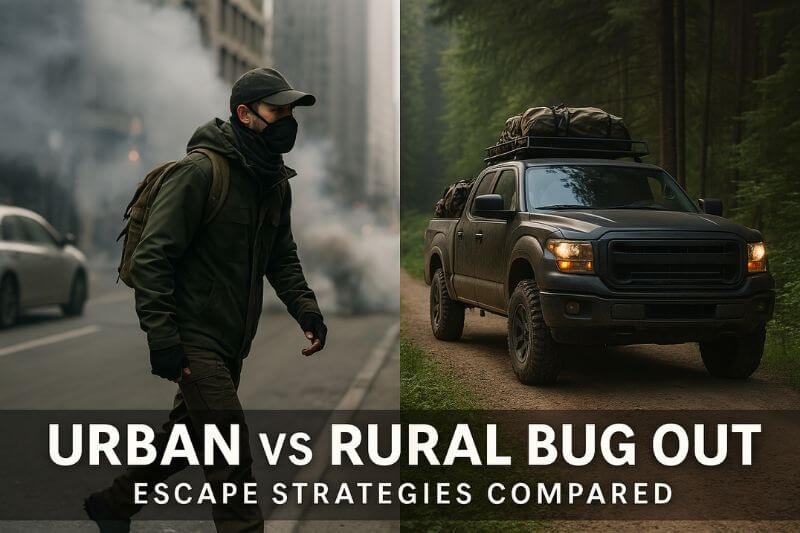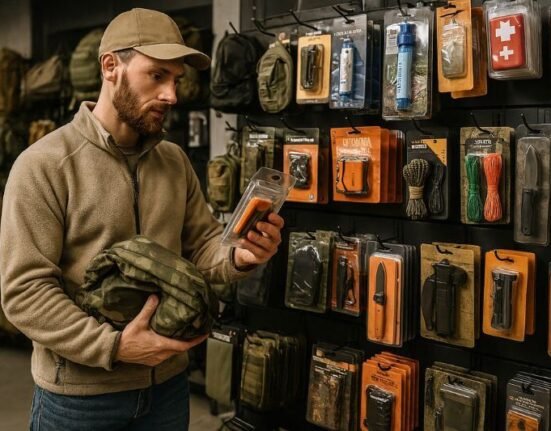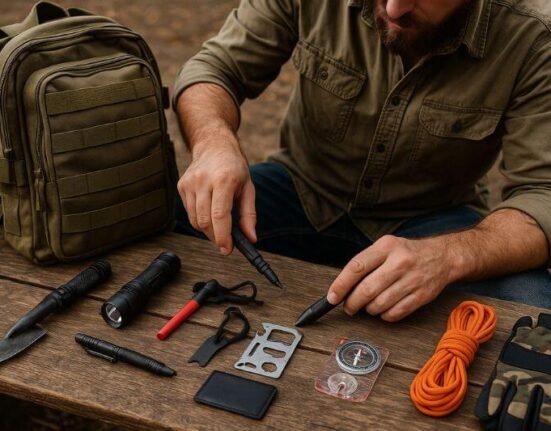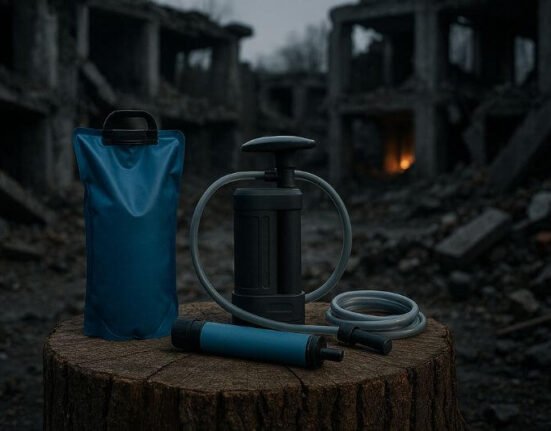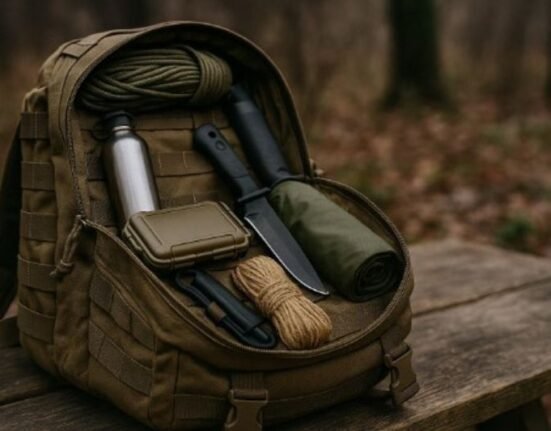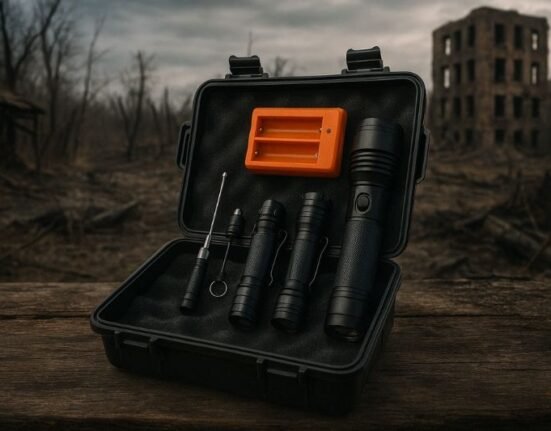When collapse hits, staying put isn’t always an option. Whether you’re trapped in a burning city or isolated on a failing homestead, sometimes survival demands that you move—and move fast.
But bugging out isn’t a one-size-fits-all operation. The way you evacuate depends entirely on where you are when the world starts falling apart.
Urban and rural environments create radically different challenges: in the city, it’s chaos, crowds, and blocked roads; in the countryside, it’s distance, exposure, and isolation.
If you don’t adapt your bug-out plan to your environment, you’re gambling with your life.
In this guide, we’ll break down exactly how bugging out differs between urban and rural settings—from escape strategies to gear choices to psychological traps—and show you how to build a dynamic evacuation plan that works when everything else is crumbling.
Because when it’s time to leave, you won’t get a second chance to get it right.
🧭 Part 1: Bugging Out in Crisis – How Environment Shapes Your Escape Plan
In any major collapse scenario, the decision to bug out can mean the difference between life and death. But here’s the catch: bugging out from a city isn’t the same as bugging out from the countryside. The risks, tactics, timing, and gear change drastically based on your location.
This is where most preppers fail—they plan a generic bug-out strategy, without factoring in whether they’ll be navigating crowded streets or crossing open terrain. That’s why understanding the difference in urban vs rural bug out planning is essential to survival.
🔥 What Does It Mean to “Bug Out”?
To bug out means to evacuate your current location—usually your home or workplace—due to an imminent or active threat. The goal? Reach a pre-planned safe location where you can survive and regroup.
Common bug-out triggers:
- Grid-down scenarios
- Civil unrest, riots
- Martial law or authoritarian lockdowns
- Natural disasters (wildfires, floods, earthquakes)
- Targeted violence, looting, or biological hazards
“Bugging out isn’t the adventure Instagram makes it look like—it’s your last resort when staying means death.”
— Clay Martin, author of “Prairie Fire”
🏙️ Urban Bug Out: Escape from the Gridlock
Bugging out from a city is like trying to run from a fire inside a maze. Your challenges begin the moment you step out your door.
Urban Bug-Out Risks:
- Chokepoints everywhere: bridges, tunnels, traffic
- Overcrowding: everyone leaves at once
- Hostile encounters: looters, roadblocks, panicked civilians
- Limited nature access: survival terrain starts miles away
Urban Escape Priorities:
- Leave early—within the first 2 hours
- Move on foot, by bike, or motorcycle (avoid cars unless roads are clear)
- Blend in—gray man tactics are crucial
- Know at least 3 alternate escape routes
🧠 Timing is everything in urban evacuation. The longer you wait, the more your city becomes a trap.
🌄 Rural Bug Out: Distance, Terrain, and Visibility
Bugging out from a rural area means you likely already have distance from chaos—but new challenges arise.
Rural Bug-Out Risks:
- Isolation: no one to help if injured or stranded
- Long travel times: distances between safe zones are greater
- Weather impact: snow, rain, or mud can immobilize vehicles
- Wildlife and terrain hazards: rivers, cliffs, predators
Rural Escape Priorities:
- Use quiet secondary roads or unmarked paths
- Prepare for vehicle breakdowns—carry repair kits or plan for foot travel
- Monitor radio or scouts for activity in surrounding zones
- Camouflage gear and vehicle to reduce visibility
🧠 In rural zones, bugging out is less about evading people and more about overcoming nature.
⚖️ Bug-Out Conditions Comparison
| Factor | Urban Bug Out | Rural Bug Out |
|---|---|---|
| Primary Threat | Overpopulation, violence, chaos | Terrain difficulty, distance, exposure |
| Transportation Challenges | Blocked roads, abandoned cars | Washed-out roads, long distances |
| Stealth vs Speed | Stealth is essential | Speed and endurance matter more |
| Tactical Movement | Alleyways, rooftops, tunnels | Trails, backroads, elevation routes |
| Navigation Difficulty | Moderate (street grid) | High (natural terrain, few markers) |
🎯 Common Bug-Out Mistakes by Environment
🚫 Urban Bug-Out Mistakes:
- Waiting too long (“I’ll leave when it gets really bad…”)
- Thinking you’ll drive out when roads are jammed
- Wearing tactical gear that draws attention
- Relying on your phone for navigation
🚫 Rural Bug-Out Mistakes:
- Not testing your route in all seasons
- Assuming you’ll never encounter threats
- Overpacking and over-relying on vehicles
- Failing to mark trails or cache supplies
“Your bug-out plan is only as strong as your worst assumption. Test it. Stress it. Break it before the world does.”
📍 Map Your Escape: Strategic Route Planning
Whether you’re in the city or country, you need multiple bug-out routes, each suited to different threats.
Visual Checklist – How Many Routes Do You Have?
- Primary highway route (only if leaving early)
- Secondary road route
- Foot path / pedestrian route
- Bike or off-road path
- Covert overnight route (travel only in darkness)
- Emergency fallback route (if others are compromised)
🧠 Urban routes must prioritize concealment. Rural routes must prioritize sustainability and endurance.
🧰 Part 2: Gear, Routes, and Destinations – Customizing Your Bug-Out Plan by Environment
Now that you understand the different dynamics of urban vs rural bug out, it’s time to build a real-world evacuation plan—one that works where you live, not just in theory.
In this section, we’ll cover:
- Bug-out bag essentials tailored to your environment
- The best transport methods for escape
- What makes a real bug-out destination viable
- Critical gear you’ll wish you packed—but only if it’s right for your terrain
🎒 Urban vs Rural Bug-Out Bag: What to Carry
The first mistake most preppers make? Building a generic bug-out bag without considering their escape context. Let’s fix that.
🏙️ Urban Bug-Out Bag Priorities:
- Lightweight & low-profile
- Compact gear for stealth movement
- Anti-crowd and close-contact tools
| Urban Essential | Why It Matters |
|---|---|
| Respirator mask (N95+) | Smoke, tear gas, dust |
| Folding pry tool | Access through doors/windows |
| Compact bolt cutters | Escape from barricades/fencing |
| Soft-shell backpack | Doesn’t draw attention (no camo) |
| Emergency whistle | Signal without yelling in chaos |
| City map with evac zones | Offline + multiple escape routes |
🧠 Urban bags are about speed, not comfort. Carry only what you need to escape fast, quietly, and efficiently.
🌄 Rural Bug-Out Bag Priorities:
- Long-distance survival
- Bushcraft and land navigation tools
- Load-bearing design for weight and durability
| Rural Essential | Why It Matters |
|---|---|
| Topographic map + compass | GPS may fail—manual navigation |
| Fire-starting kit (flint/lighter) | Wet terrain, no electricity |
| Fixed-blade knife + saw | Building shelter, cutting branches |
| Water bladder + filters | Streams, ponds—must purify |
| Rain gear + thermal layers | Weather shifts = survival risk |
| Lightweight tarp or bivy | Shelter on the move |
🧠 Rural bags need to support multi-day autonomy—no resupply, no help, just you and the land.
🚚 Urban vs Rural Transportation: What Gets You Out Alive
🏙️ Urban Bug-Out Vehicles (or Lack Thereof)
- 🚷 Cars = traffic traps unless you leave early
- 🚲 Bicycles are gold in blocked streets
- 🏃 On foot is often safest—especially if stealth is needed
- 🛵 Motorcycles or e-bikes for speed + maneuverability
“Every vehicle becomes a liability when streets jam. Escape routes become choke points. Escape early or go light.”
🌄 Rural Bug-Out Transport
- 🚙 4×4 vehicle with off-road capability
- 🛻 Pickup with gear, gas, food, and traction tools
- 🐎 Horses (where realistic) = fuel-free transport
- 🥾 Ready to ditch the ride and go on foot
🧠 In rural settings, vehicle durability and range matter more than speed. And always plan for the moment when your engine dies.
🏕️ The Destination Question: Where Are You Going?
The worst bug-out plan is one that ends with “…and then I figure it out.”
☠️ Bad Bug-Out “Destinations”:
- A public park or open field
- National forest with no shelter or water access
- Friend’s cabin you’ve never visited
- Any location without cache, access, or permission
✅ Safe Bug-Out Destinations Must Have:
| Feature | Why It’s Non-Negotiable |
|---|---|
| Water source nearby | River, stream, spring |
| Shelter (natural or built) | Weather protection |
| Seclusion, cover | Invisible from roads or aerial views |
| Pre-stocked cache | Food, med, tools (rotate annually) |
| Defined perimeter | Easy to secure, monitor, or booby-trap |
🧠 Tip: Pre-stage multiple bug-out caches en route to your final location. One compromised checkpoint shouldn’t end your journey.
🧠 Bug-Out Psychology: Staying Sharp on the Move
Evacuation isn’t just physical—it’s emotional. Panic, noise, and exhaustion crush untrained preppers fast.
Urban Evacuation Stressors:
- Crowds screaming, crying, fighting
- Fires, broken glass, sirens
- Decisions under extreme pressure
Rural Evacuation Stressors:
- Silence, isolation, exposure
- Physical exhaustion over long distances
- Decision fatigue from navigating terrain
“A bug-out plan isn’t just movement—it’s mental discipline under fire. You don’t rise to the occasion—you fall to your level of training.”
🚨 Part 3: When to Leave, Adapting Under Pressure, and Real-Time Bug-Out Execution
Even the most detailed bug-out plan can fail if you leave too late—or too early. Timing your exit, reading your environment, and adapting when chaos hits are what define a successful evacuation.
This final part breaks down:
- How to identify the “go-now” moment
- How to adapt when your plan falls apart
- What makes a bug-out strategy truly dynamic
Because no matter where you live—urban or rural—static plans get people killed. Flexible ones save lives.
⏱️ When Is the Right Time to Bug Out?
This is the million-dollar question. Leave too early and you may abandon a perfectly safe home. Leave too late, and you’ll be caught in riots, roadblocks, or martial law.
✅ Urban “Go-Now” Triggers:
- Grid failure + no comms for 12+ hours
- Fires, looting, or violence spreading toward your zone
- Martial law declared or military deployment nearby
- Emergency broadcasts urging relocation
- Water taps go dry + stores empty = last window
🧠 Urban bug-outs are often instant reactions—delayed only by disbelief.
✅ Rural “Go-Now” Triggers:
- Surrounding areas show high movement or conflict
- Natural disaster (wildfire, flood, tornado) imminent
- Loss of key infrastructure (well, generator, food storage)
- Attack or infiltration of your homestead
- Medical emergency + no access to treatment
🧠 Rural bug-outs are strategic withdrawals—made with calculation, not panic.
🔁 What If Your Plan Fails?
The best bug-out strategy includes real-time contingency adaptation. You need to be mentally ready to throw out your plan when reality doesn’t match.
Common Failures (Urban):
- Primary route blocked? Switch to footpath or subway line
- Bug-out vehicle stolen or destroyed? Have a bike or be ready to walk
- Safehouse compromised? Rotate to secondary location or temporary hideout
Common Failures (Rural):
- River crossing impossible? Circle upstream and build a crossing
- Bug-out trail snowed in or mud-locked? Use elevation contouring
- Prepped location occupied? Activate “Plan Bravo”—even if it means sleeping in the woods for 48 hours
“The plan is nothing. Planning is everything. You survive by adapting—not following step-by-step checklists.”
🧭 The Adaptive Bug-Out Framework
Use this system to decide what to do in real time, no matter where you are:
- Assess: What just changed? What no longer applies?
- Decide: Stay, detour, or abandon original plan?
- Act: Decisive, fluid movement—never freeze.
- Communicate: If in a group, use hand signals or pre-planned codes.
- Fallback: Always have a direction, not just a destination.
🧠 Carry a printed copy of this system in your bug-out bag.
🏕️ Building Your Bug-Out Zone Network
One bug-out location = one point of failure.
You need a network of possible fallback spots. Especially in rural terrain, these can be primitive and spread out:
Build a “Zone Defense” System:
- 🔹 Primary Bug-Out Location: stocked and fortified
- 🔸 Secondary Shelter: temporary, camouflaged, water access
- 🔹 Tertiary Cache Site: buried gear, medical, comms
- 🔸 Recon Overwatch Point: to observe movement and traffic
- 🔹 Safe Meeting Point: in case of group separation
Use natural markers, GPS coordinates, or code maps—but never mark them obviously on paper or devices.
🎯 Urban vs Rural Bug Out: Final Strategy Matrix
| Element | Urban Strategy | Rural Strategy |
|---|---|---|
| Decision Time | Fast, reactive | Strategic, calculated |
| Mobility | Lightweight, stealth-based | Endurance, long-range capability |
| Gear Focus | Concealment, defense, escape tools | Sustainability, repair, weatherproofing |
| Transportation | Foot, bike, public infrastructure | Vehicle, horse, or hike with heavy load |
| Navigation | Streets, tunnels, rooftops | Maps, compass, landmarks |
| Shelter Plan | Temporary safehouses, hideouts | Off-grid locations, cabin/bunker systems |
| Threat Type | Human-heavy: mobs, riots, gangs | Environmental: exposure, terrain, animals |
🧠 Final Thoughts: Don’t Just Have a Bug-Out Plan—Have a Bug-Out Philosophy
Bugging out isn’t an action. It’s a mindset. It’s the belief that:
- Staying is no longer survivable
- Everything you need is already on your back
- You’re not just running—you’re moving toward resilience
Urban or rural, your survival depends on your ability to move smart, act fast, and adapt instantly.
“Escape is not failure. It’s foresight.”
❓ FAQ – Urban vs Rural Bug Out
Q1: Should I always have a bug-out bag with me?
Yes. Keep a compact EDC bag with core survival items at all times, especially in urban zones.
Q2: Is bugging out from a rural location common?
Not as common—but still necessary when defensive or supply systems fail. Never assume you’ll “ride it out” no matter what.
Q3: How far should my bug-out location be?
Minimum 1–2 days’ walk from major population centers. Far enough for safety, close enough to reach on foot if needed.
Q4: Can I bug out with kids or elderly relatives?
Yes—but it requires custom planning, load reduction, and group coordination. Check out our Family Bug Out Plan for full guidance.









